Tillandsia confertiflora
Click thumbnails for full size, scaled to a new window.
Tillandsia confertiflora
Species, Ecuador.
See notes attached to T. confinis regarding confertiflora, confinis, dudleyi, and others.
Note also, confinis minor is treated as a synonym of confertiflora.
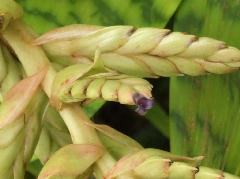
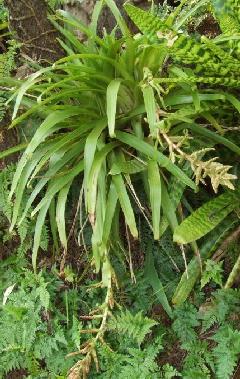
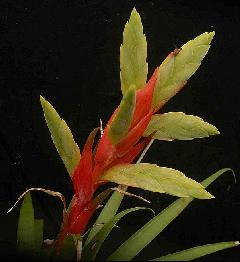
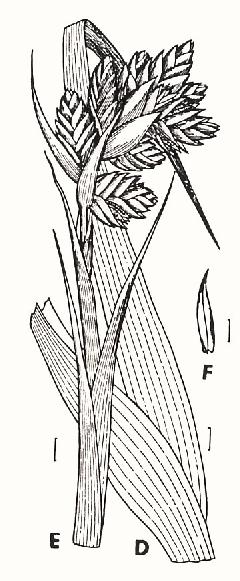
| David Sheumack. (Probably T. coinanensis). |
Chris Larson. |
Drawing. |
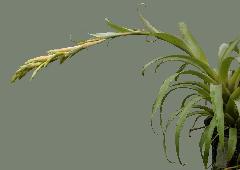
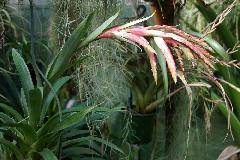

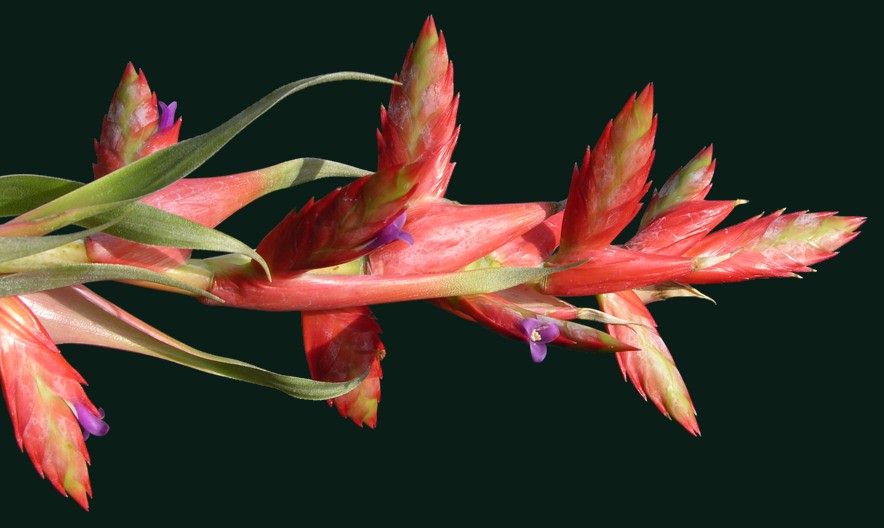
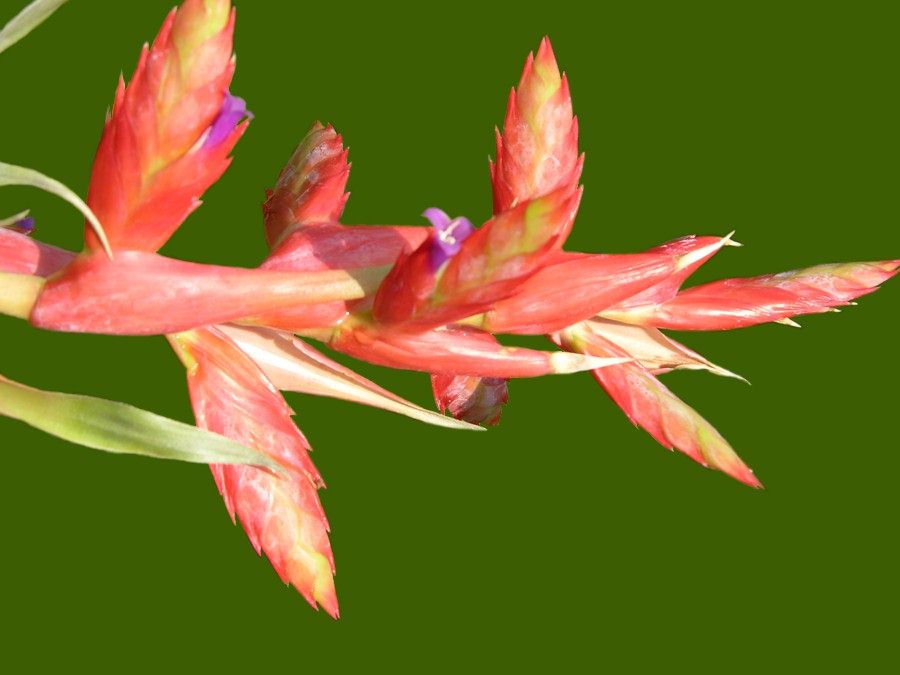
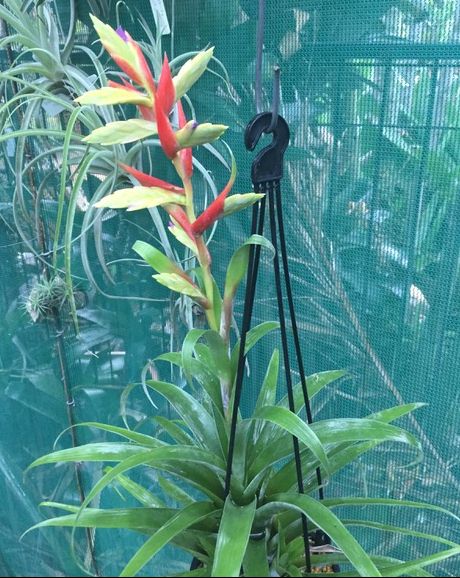
| Len Colgan 07/10/11. As T. confinis |
John Olsen 12/18 |
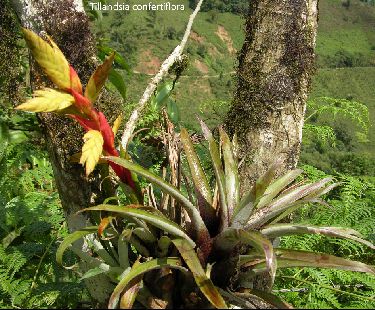
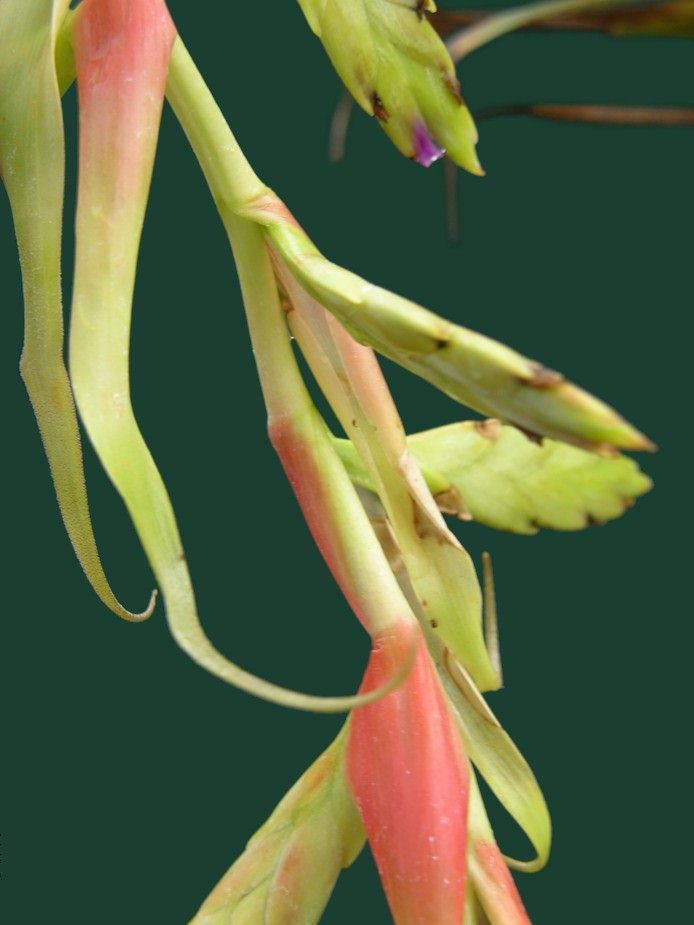
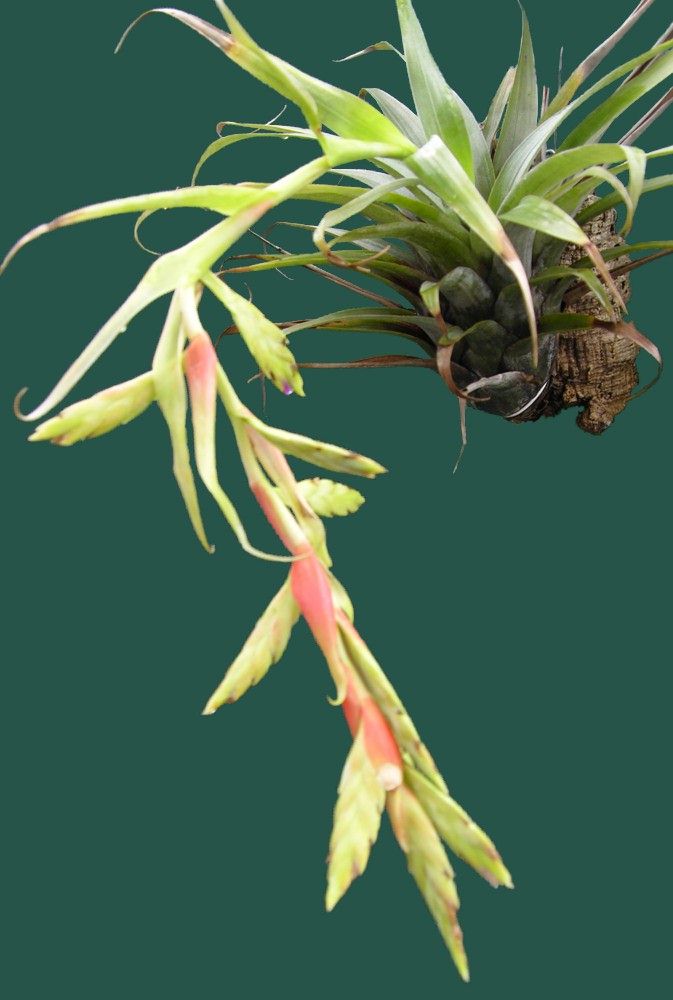
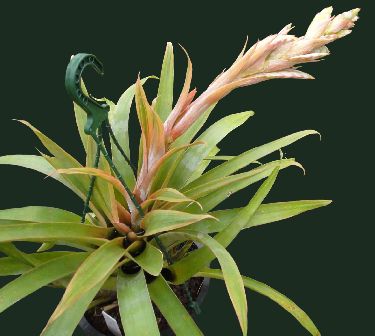
| Len Colgan 07/10/11. |
Chris Larson 11/12. Large form ex-Bak. 8" pot. Note variegation! |
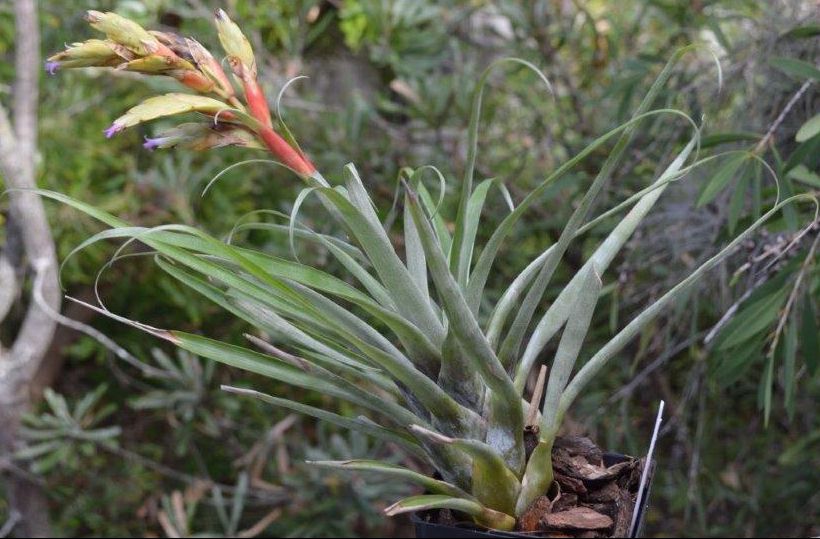
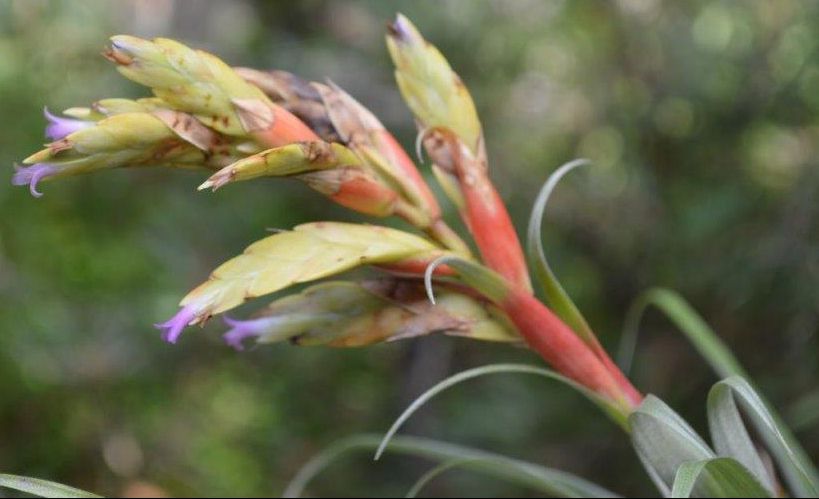
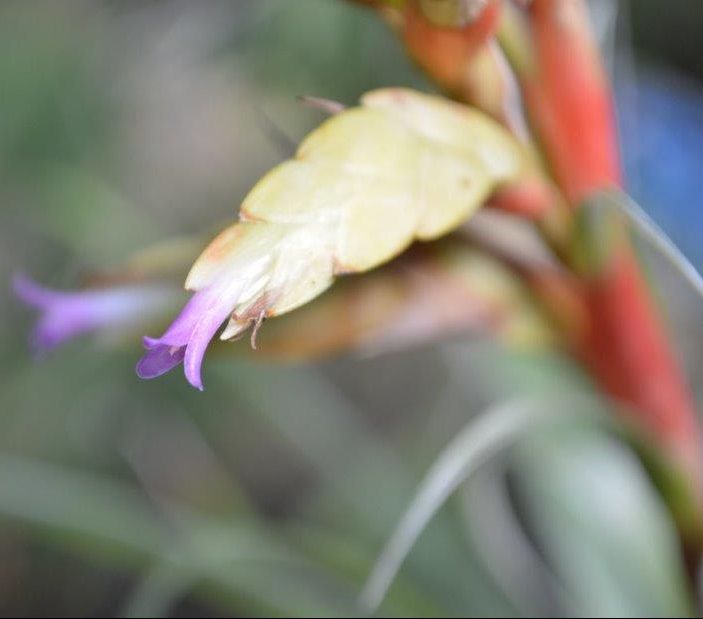
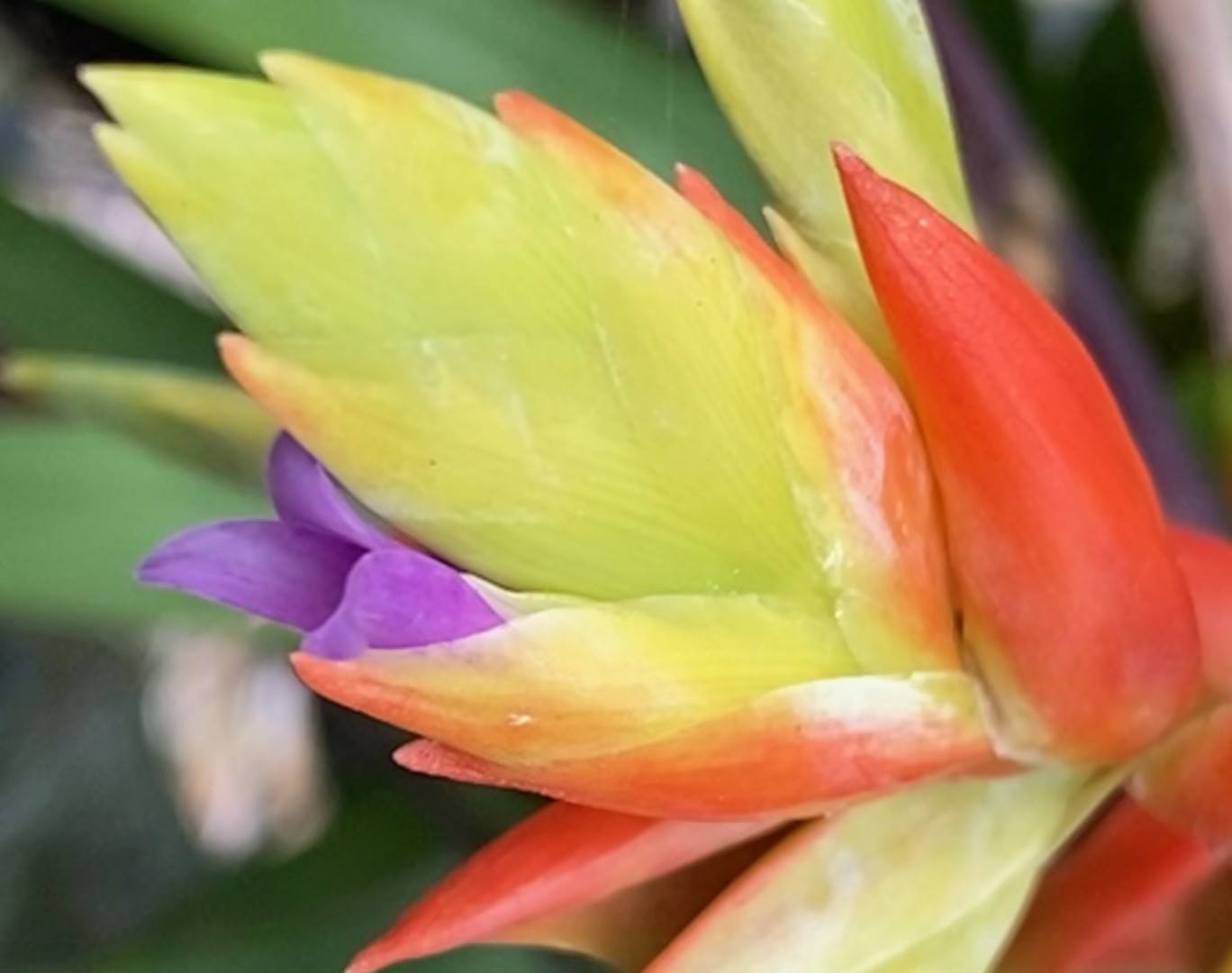
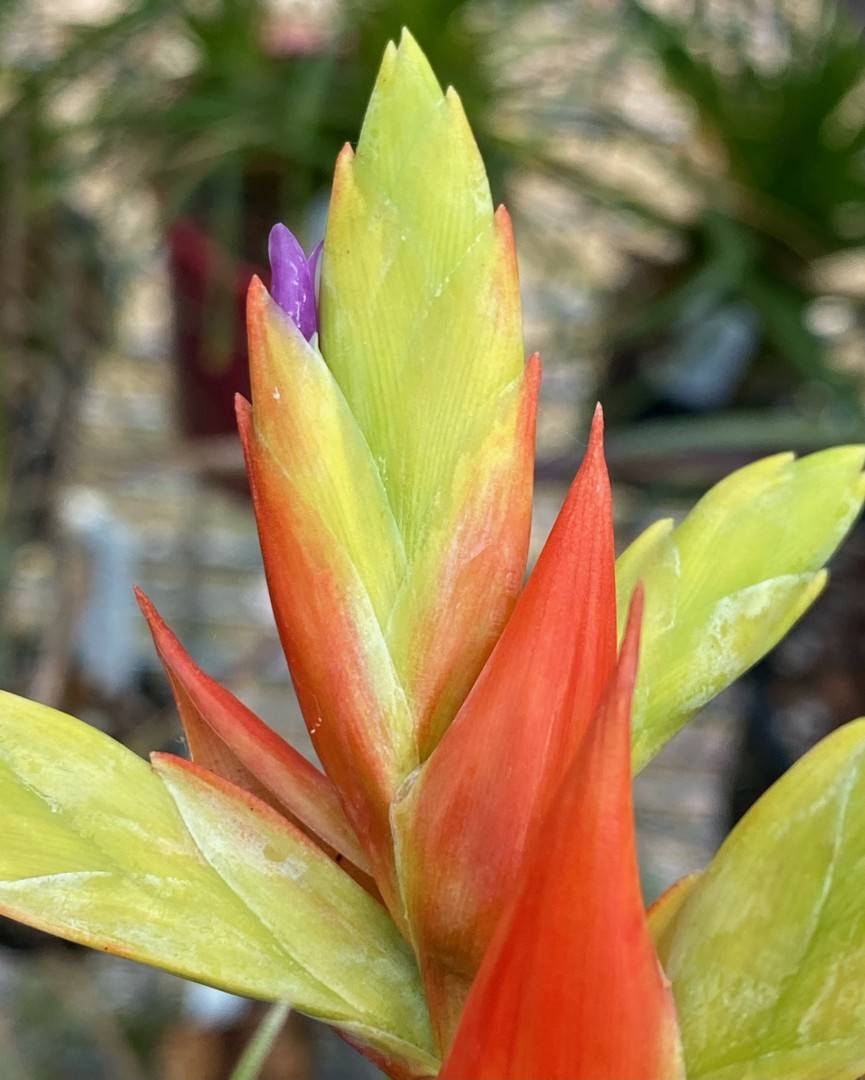
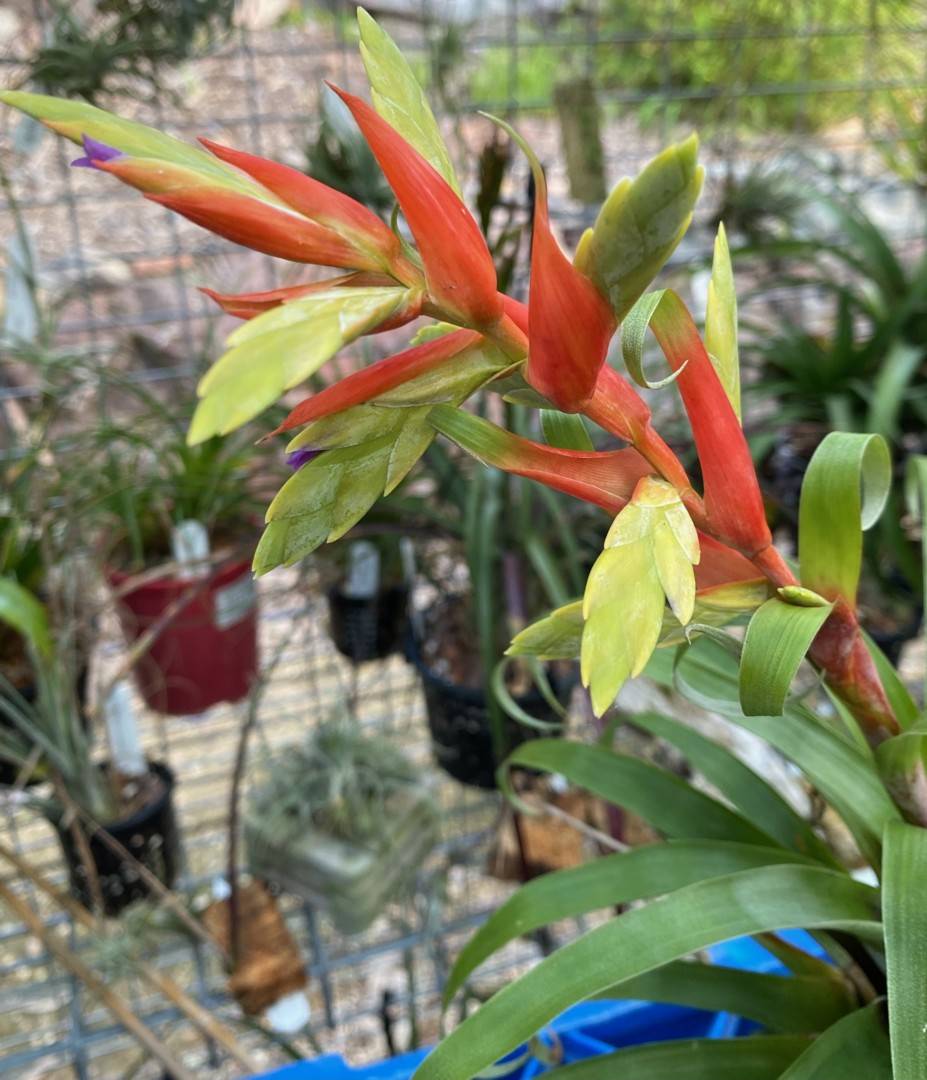
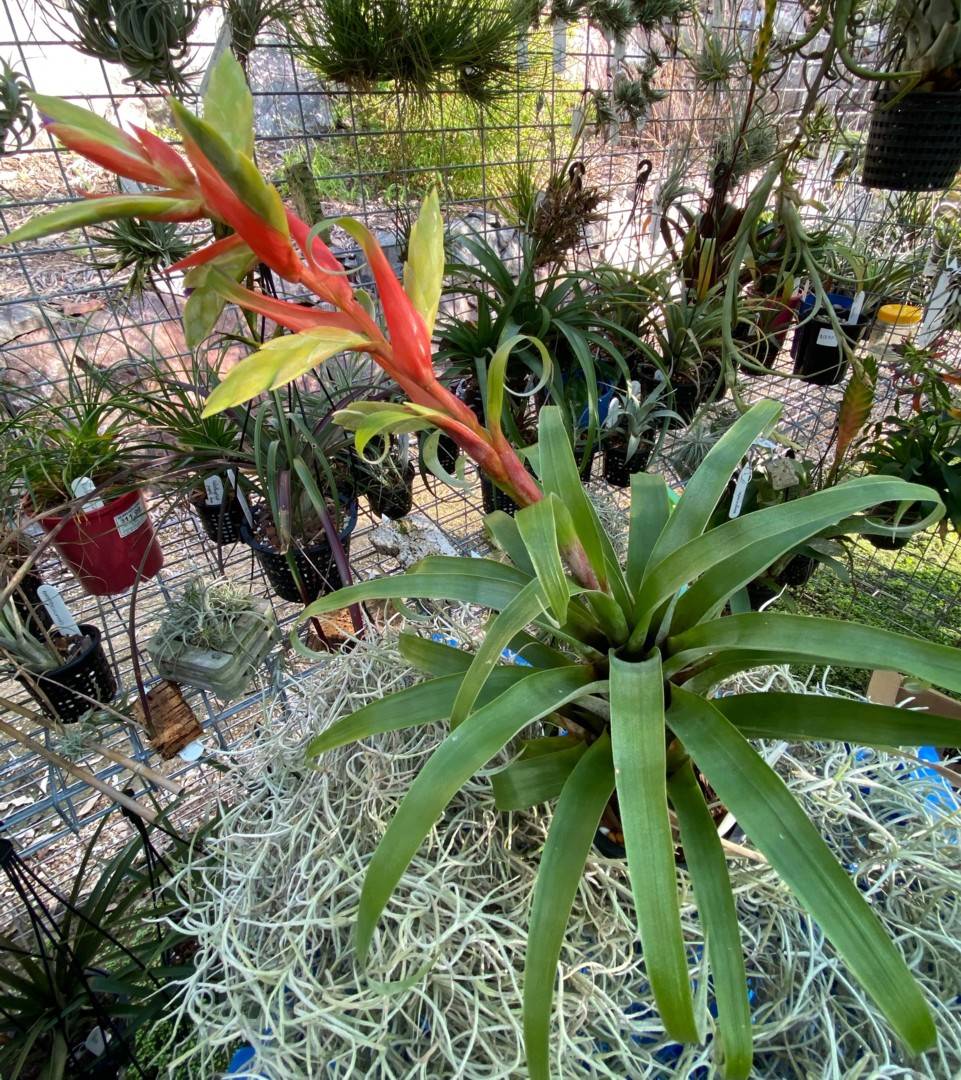
| Dale Dixon 12/21 (Note: Eric Gouda considers this to be confinis) |
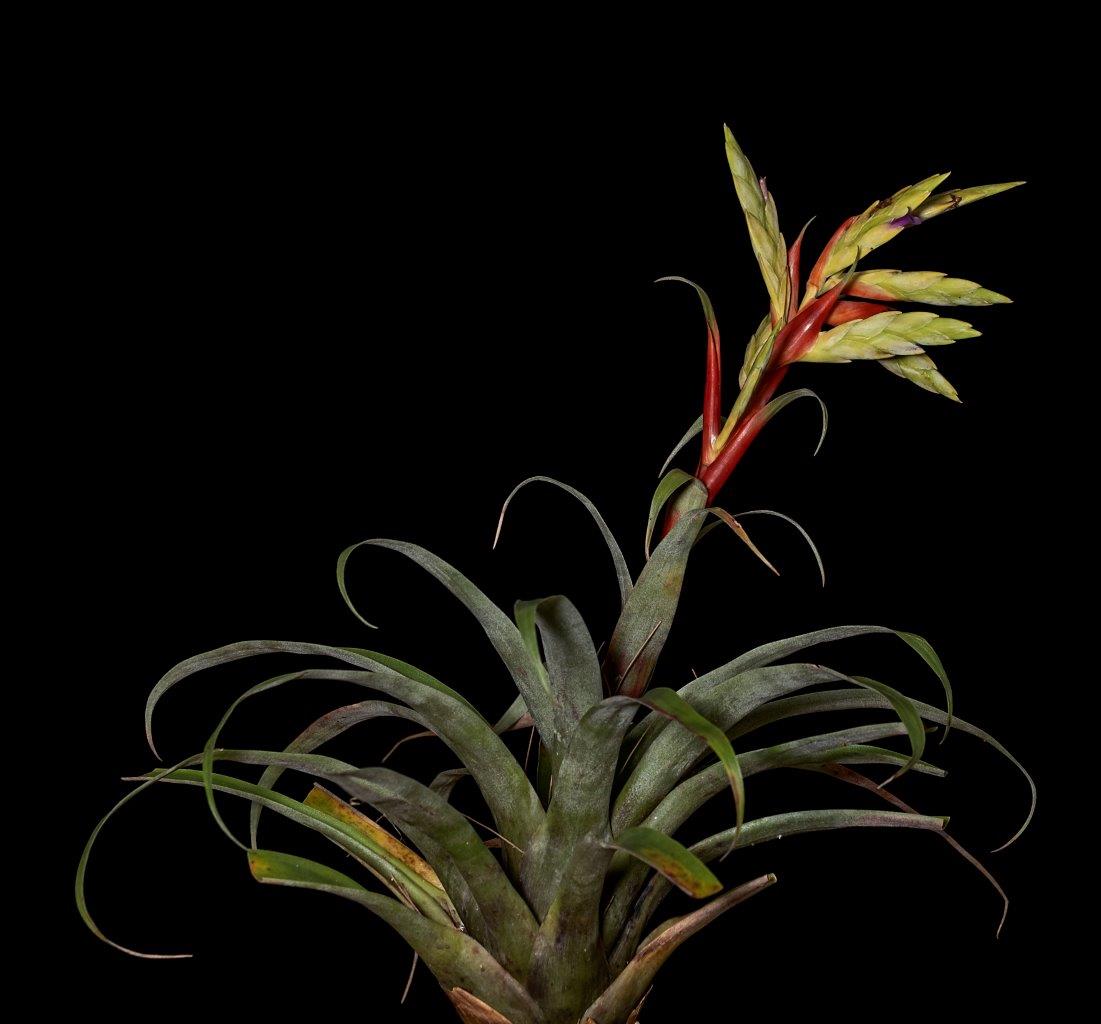
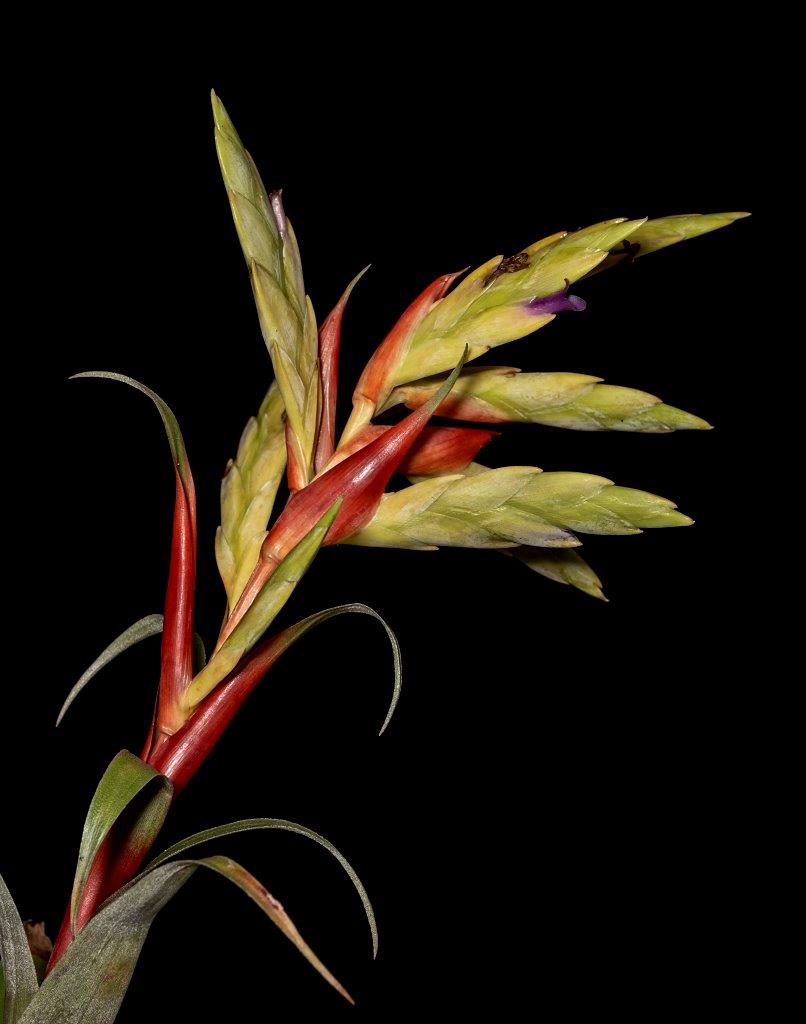
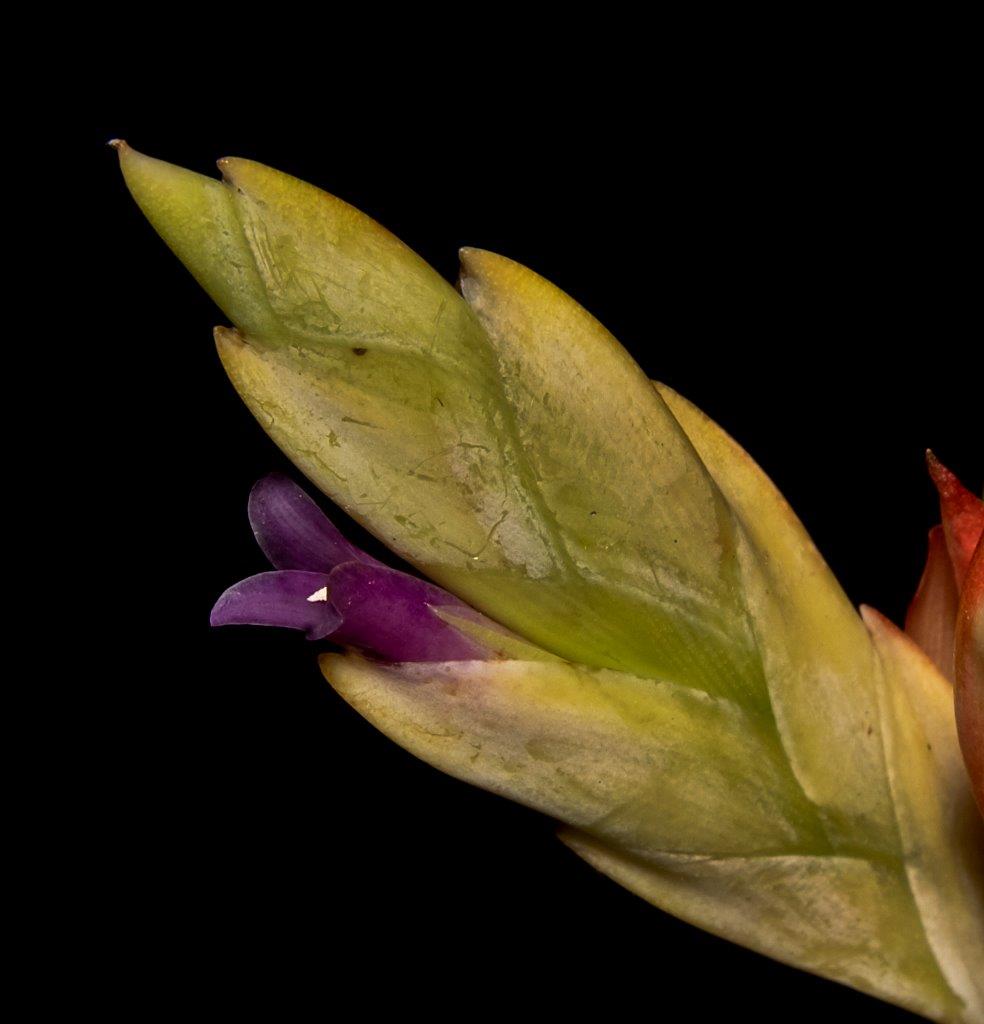
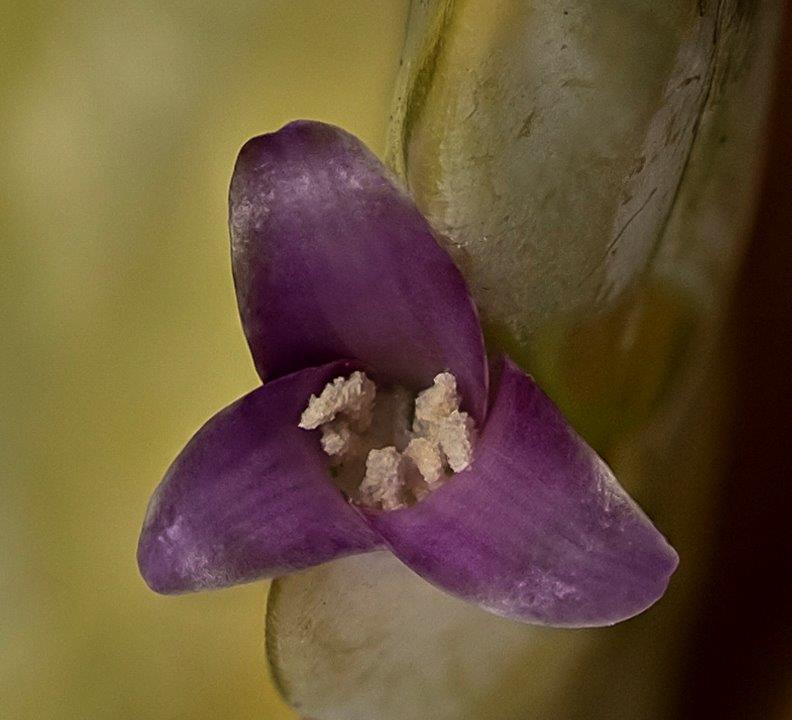
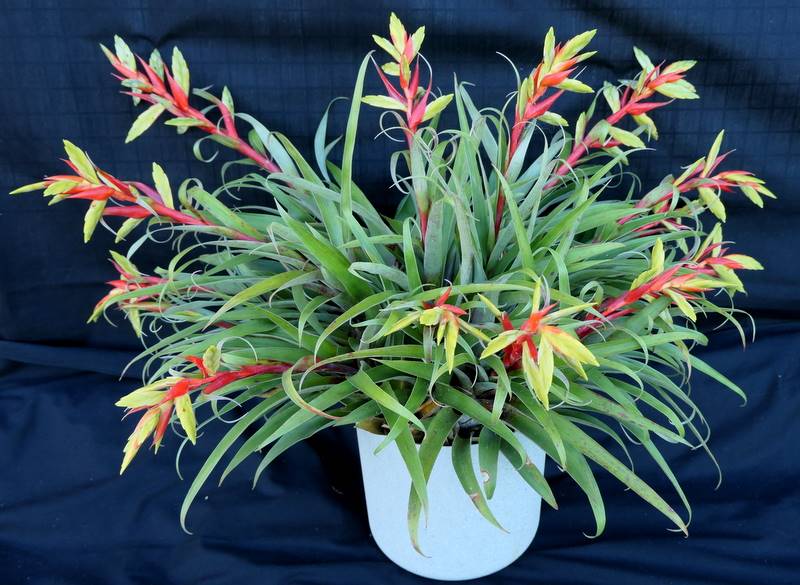
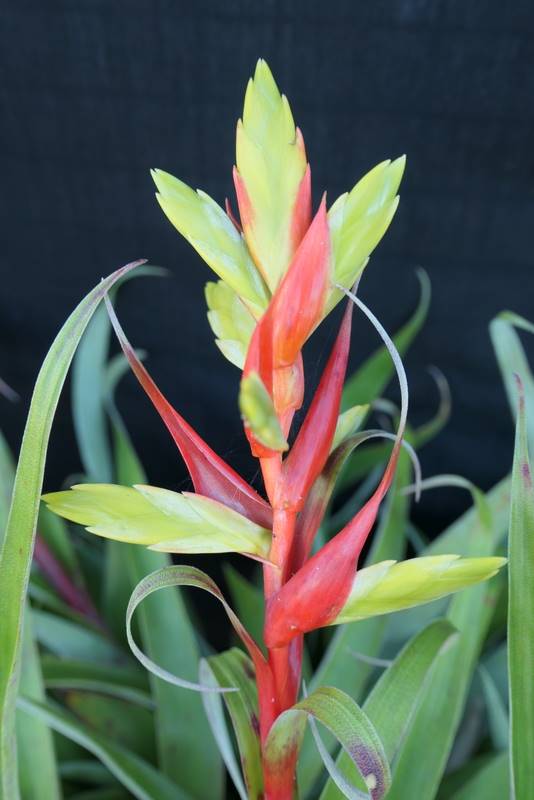
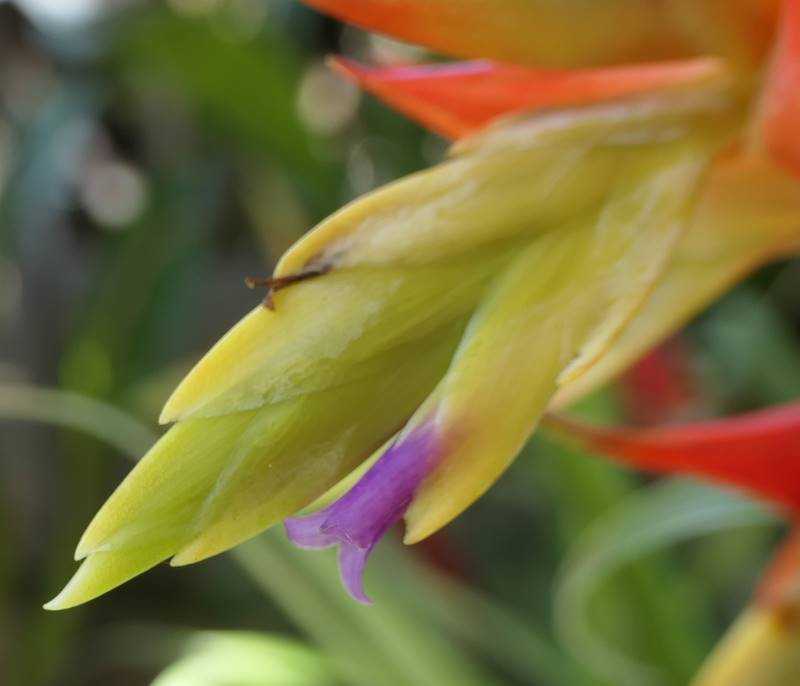
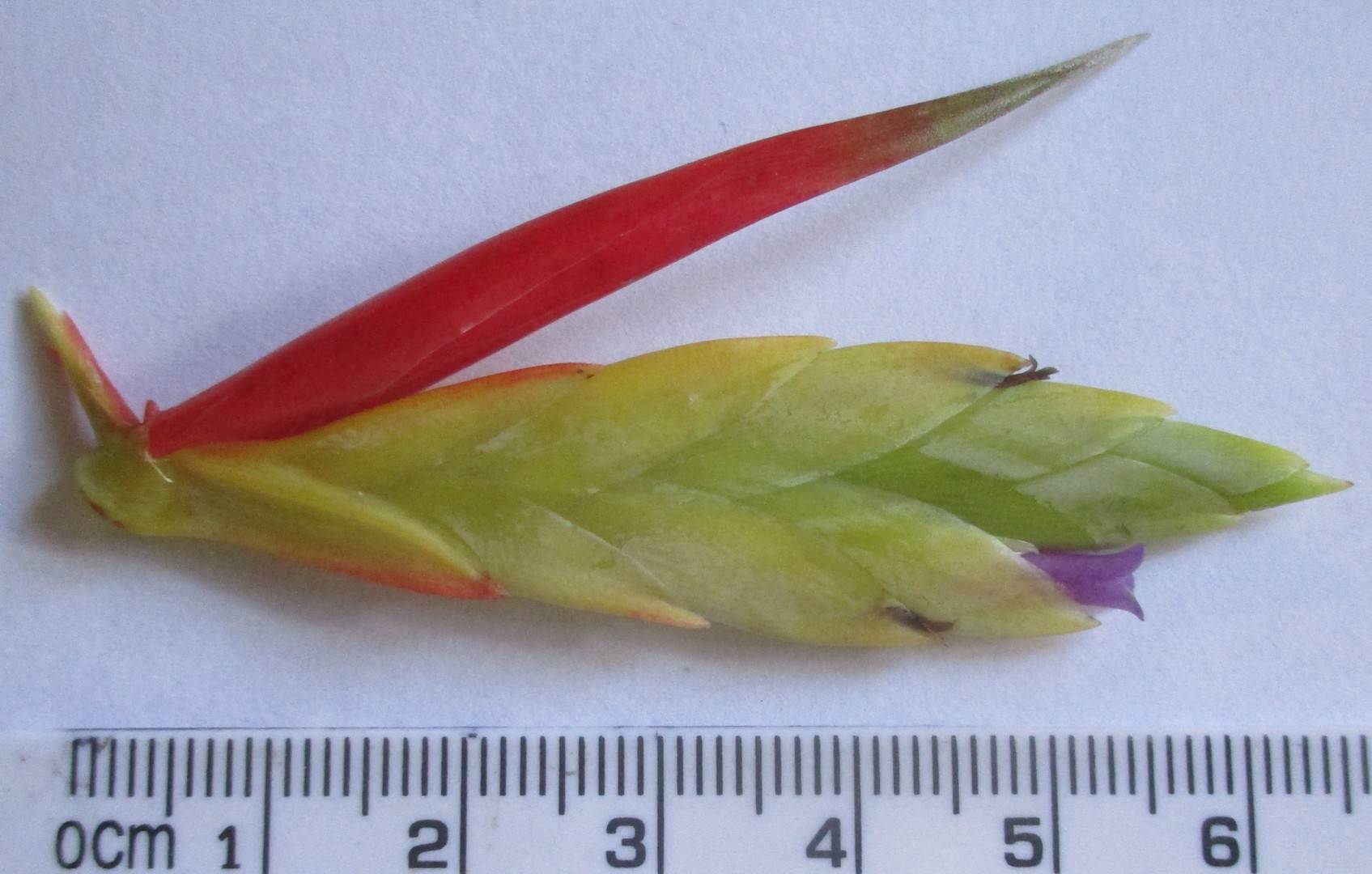
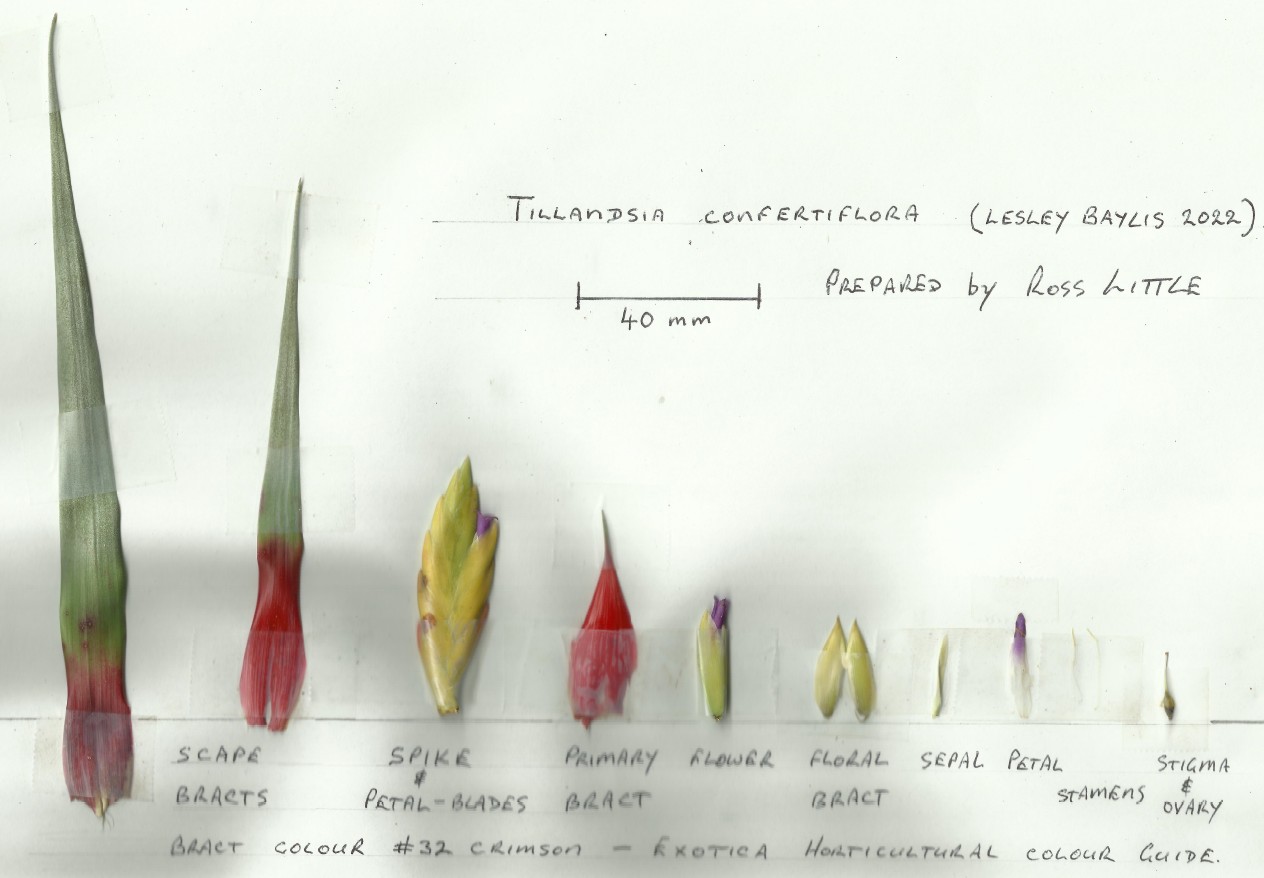
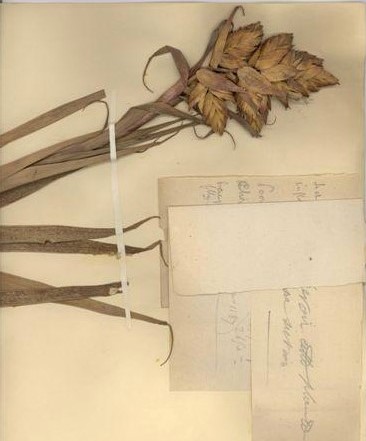
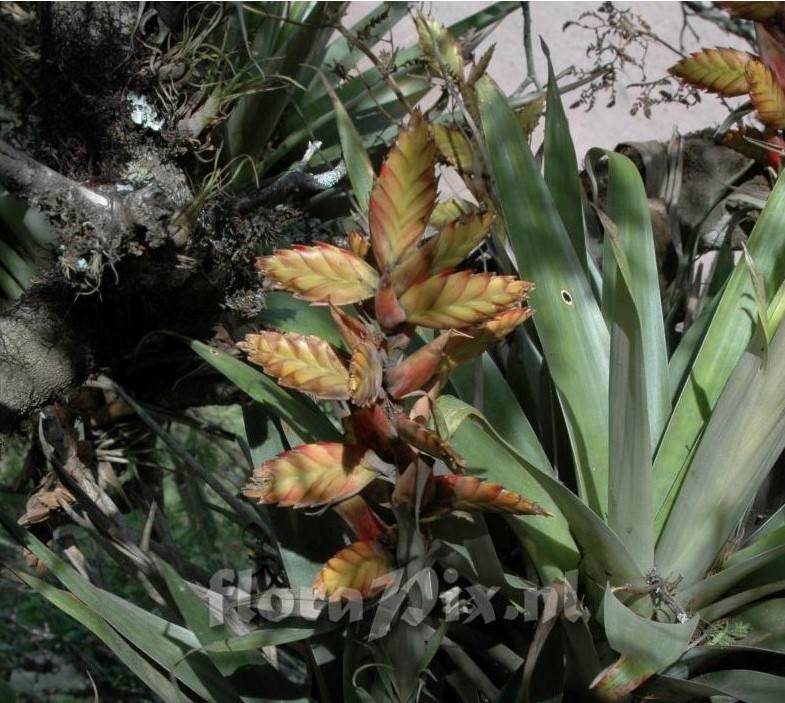
| Ross Little 01/22 |
Eric Gouda 01/22 confertiflora see notes below |
Dale Dixon ... "Pretty sure this is the one that Eric Gouda says is Tillandsia confinis. I flowered it about a month ago and posted to the group. What are the label details on yours?"
Rob Bower ... "Not much on label except I got it from Chris Larson. My amateur guess it that the one you flowered was confinis and mine is confertiflora - from the other emails it was previously confinis v minor. That ties in with the fact yours was a larger longer flower spike. Lesley's recent confertiflora pic is pretty much the same as mine. Hers came from Peter Tristram."
Chris Larson ... "Jeff Kents plants often have collection data - this is a plant Bob Hudson, Peter Tristram and I imported from Jeff Kent. The habitat data show that T. confertiflora and T. confinis are separated by some distance. T. confinis coming from around Cuzco, where T. confertiflora comes from far north of Peru and into Ecuador. Does anyone have contact with Jeff to find out if he has detail? Peter?
Or has anyone checked this plant against the 2 descriptions?"
Peter Tristram ... "I have emailed Jeff Kent. See what we find out. Doug Binns sent me photos of what looks like this plant a few years ago. Remember, confertiflora used to be confinis v minor. Also the dvd will do your head in regarding this group. There are many descriptions!! Bolivia to Colombia is a wide habitat range."
Lesley Baylis _t ... "This is my T. confertiflora, flowering now, which I believe I acquired from Peter Tristram some years ago. I'm definitely a clumper...!! and slightly panicking as Ross Little wants an inflorescence so that he can do some butchering.
It's not looking its best as we've had a bucket load of rain and no sunshine for several weeks... but still I don't think I'll be letting it out of my sight.... for too long...!!"
Dale Dixon ... "Mine is exactly the same as Lesley’s. It’s a small plant. Orange bracts are confinis. Red bracts confertiflora."
Ross Little ... "With a little persuasion Lesley allowed me to remove one of her 14 precious inflorescences from her awesome clump of Tillandsia confertiflora to chop up and check its bits, photos attached.
Comparison check taken from the Butcher files: Till. confertiflora Andre and Till. confinis L.B.Smith
Till. confertiflora petals, 5 mm, blue violet .... yes, agrees.
Till. confinis petals 7 mm, white .... no.
Regarding bract colour: bract colour can vary with light, temperature and humidity.
Till. confertiflora scape bracts and primary bracts – bright red.
Till. confinis upper scape bracts with red sheaths.
I saw an orange bracted form in Ecuador in 2015, whether it was confertiflora or confinis ?? no petal colour to confirm.
For those better at checking the finer details than me, refer to the herbarium I have prepared today from Lesley’s plant, let me know if you require more details and photos."
Peter Tristram ... "Hi Ross, all: In my opinion don’t change the labels. On the way to Brisbane Ross and I went over the bits kindly donated by Lesley, at Pine Grove. Great job preparing the sheet, too, Ross - reminds me of the good old days. Seems a good match to confertiflora to me. Always check a plant against the type specimen and other herbaria material too, as in the DVD. Check the floral parts in particular first as, if they don't match, the rest is a waste of time. Species identification is more about the finer details than the overall look, which is a guess… I guess.
Jeff Kent last sent me this info:
"I collected it in west central Ecuador at 1200 msm. The same area as Tillandsia mima and Ae. mexicana but a bit higher in elevation. I need to look up the locality. The other form is from Eastern Peru at 1500+ msm in the Alto Mayo region and is more difficult to grow. It burns if fertilized too much."
I can't remember the 'other form'.
I await another email with locality. Jeffrey is a wonderful library of collection info. I think I need another couple of days in his greenhouses, especially after his more recent trips to Ecuador and Colombia!"
Eric Gouda ... "Hope not to make the confusion even larger, but I think this plant under discussion is T. confinis again.
I think T. confertiflora has short ovate spikes and those in T. confinis are more lanceolate, see the type photo above of the André plant. The protologue says that the leaves are densely lepidote, flowers white.
Also see florapix image above that is probably T. confertiflora, petals were not seen, but inflorescence looks much like it."
Bruce Dunstan ... "Photos below are the smaller Kent clone from Peter Tristram. Then a comparison shot with a larger clone from John Olsen and by itself. The last couple of images show Chris Larson's plant."
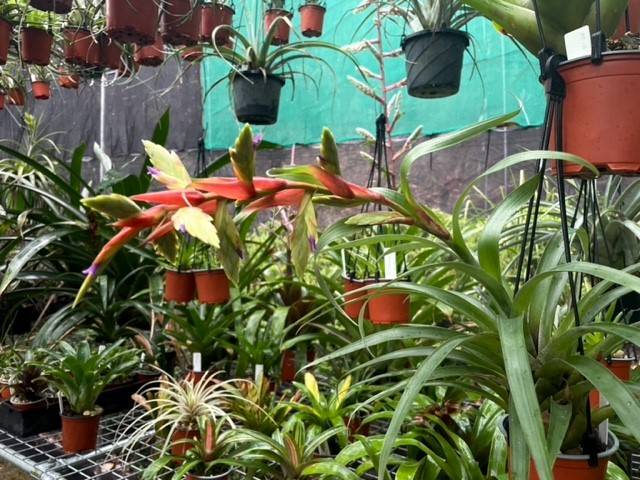
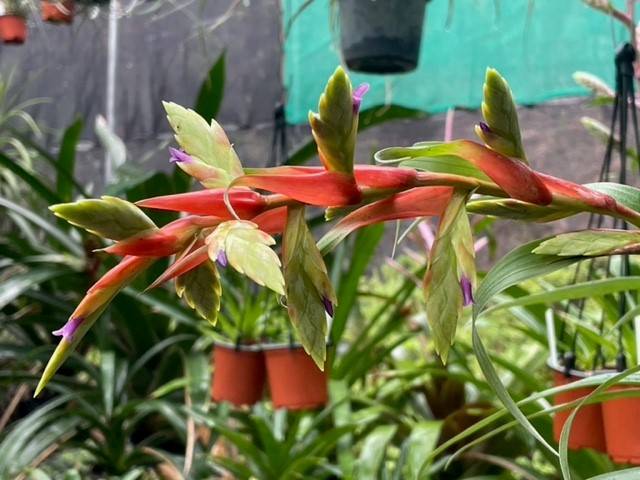
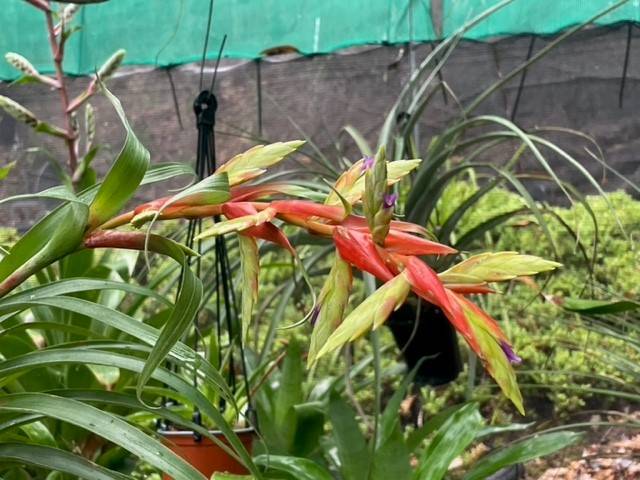
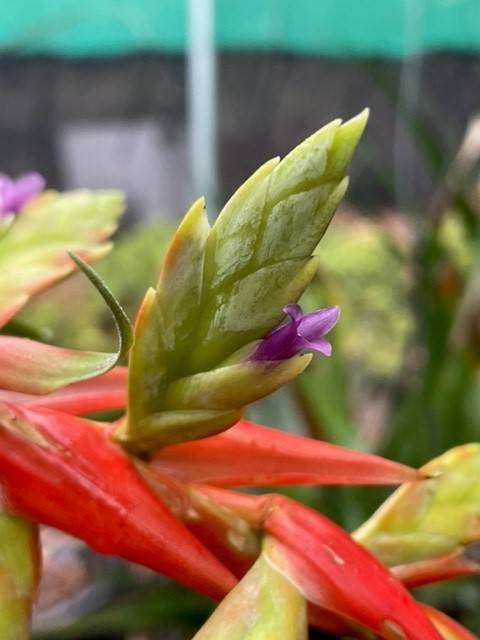
| Bruce Dunstan 01/23 Smaller Kent clone ex. Peter Tristram |
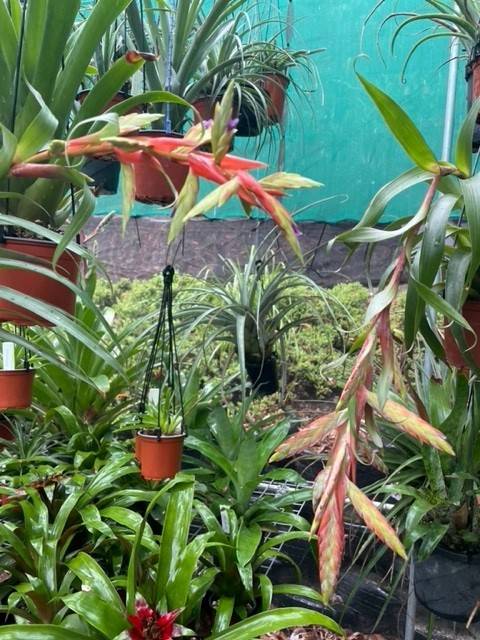
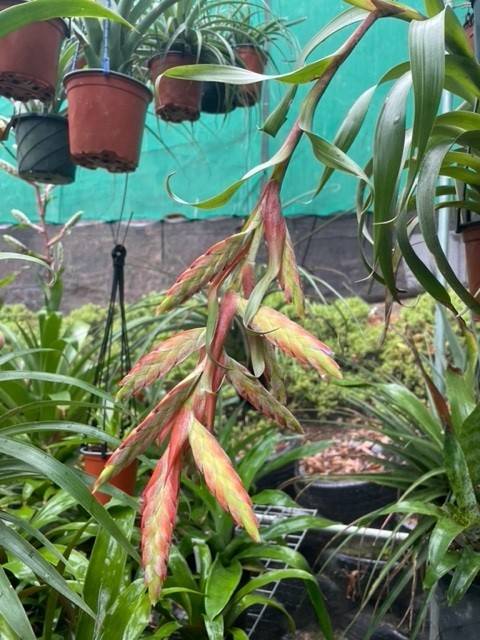
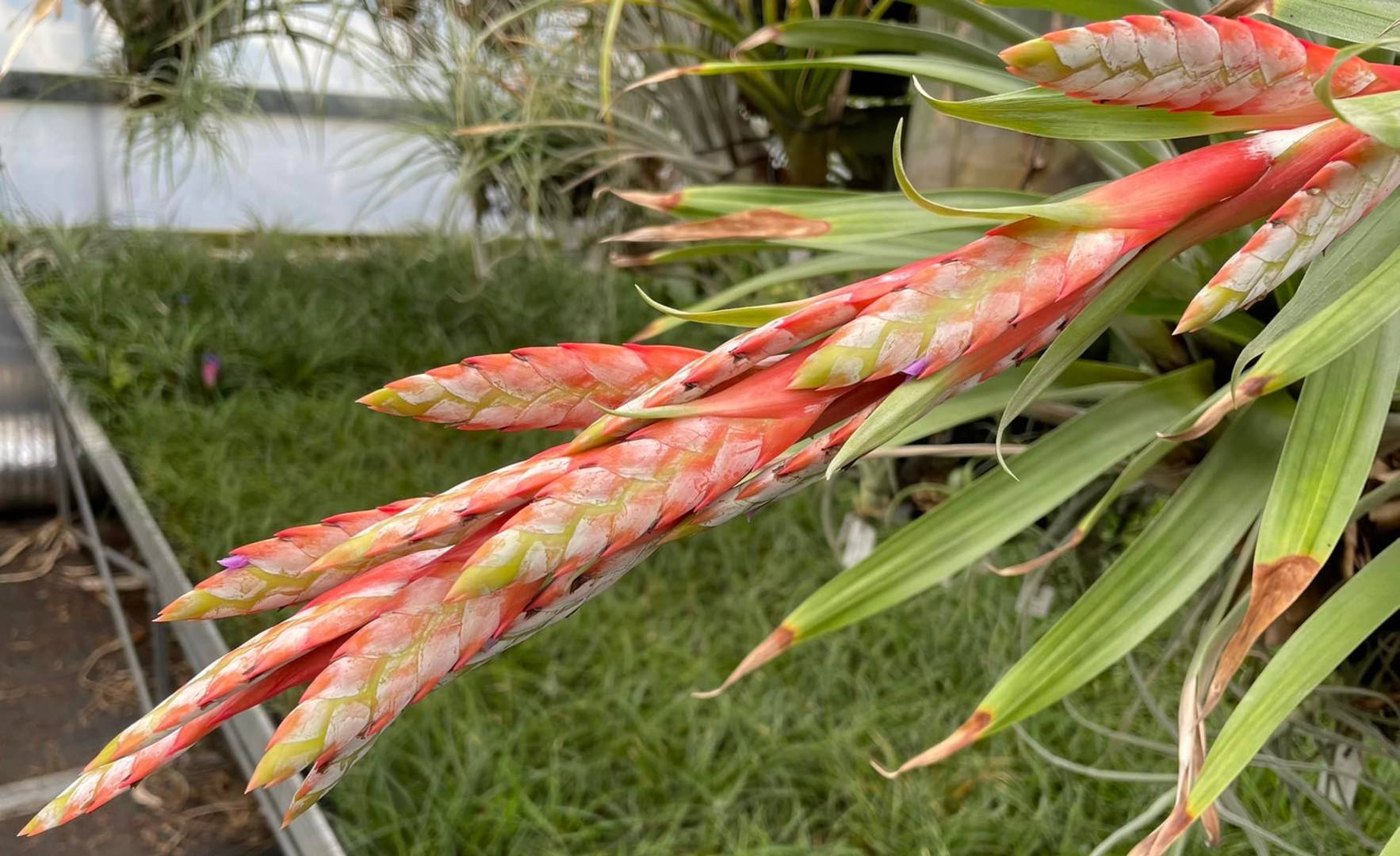
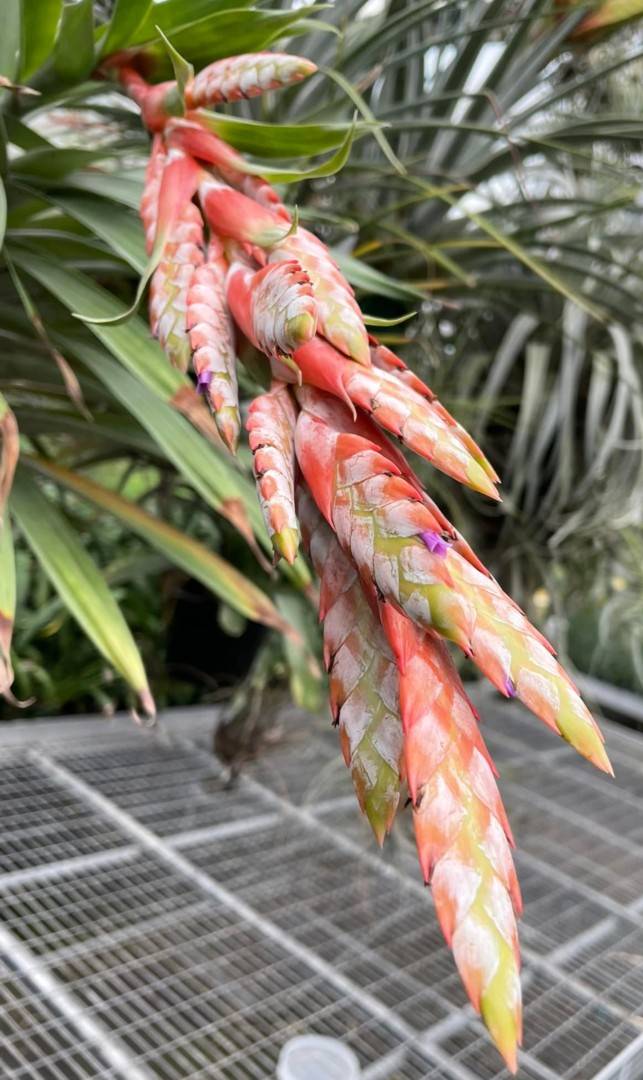
| Bruce Dunstan 01/23 Kent V. bigger Olsen clone |
Bruce Dunstan 01/23 Olsen clone |
Bruce Dunstan 08/22 ex Chris Larson |
Tillandsia confertiflora Andre, Enum. Bromel. 7. 13 Dec 1888; Revue Hort. 60: 567. 16 Dec 1888. .
Tillandsia confinis var. minor Rutschmann & Rauh Trop. Subtrop. Pflanzenwelt 65:47-9 1988 treated as a synonym in Binomial listing 6. 1998
Desc from S&D p784
Plant stemless, flowering 3-5 dm high.
Leaves utriculate-rosulate, 3-4 dm long;
Sheaths distinct, elliptic, covered with very closely appressed brown-centered scales, dark purple;
Blades narrowly triangular, caudate-attenuate, 3-4 cm wide, flat, densely cinereous-lepidote beneath, more or less glabrescent and green above.
Scape curved, equaling the leaves or shorter, glabrous;
Scape-bracts densely imbricate, lanceolate with foliaceous blades, the upper bright red.
Inflorescence very densely bipinnate, ellipsoid, 10-15 cm long, 7 cm in diameter;
Primary bracts triangular-ovate, bright red, the lower ones equaling or exceeding the spikes, the lower and median subfoliaceous-laminate;
Spikes suberect, subsessile, ovate-elliptic, subacute, 35-45 mm long, 20 mm wide, complanate, 10-14-flowered.
Floral bracts very densely imbricate and concealing the rhachis, ovate, acute, to 25 mm long, 15 mm wide, exceeding the sepals, sharply carinate, coriaceous, even, glabrous, lustrous;
Flowers subsessile.
Sepals lanceolate, acute, 16-20 mm long, about half-connate posteriorly, chartaceous, glabrous;
Petal-blades elliptic, 5 mm long, yellowish white to blue violet;
Stamens and pistil included.
Capsule slightly exceeding the bract.
Type. Andre 4475 his (holotype K, GH photo), without exact locality, Andes of Central Ecuador, 1876. (Holotype NOT at Kew – DB!)
DISTRIBUTION. Epiphytic, 1200-2500 m alt, Ecuador, northern Peru.
ECUADOR. LOJA: Chinchanga, Poortman 478 (P); El Almendral, Catacocha, 16 Apr 1944, Acosta Solis 7895 (F). PERU. PIURA: Cambaque, Olmos Valley, Rauh P-308 (US)
Tillandsia confinis L. B. SMITH var. minor J. Rutschmann et Rauh , Trop Subtrop. Pflanz.65: 47-49. 1988
Treated as a synonym in Binomial listing 6. 1998
A typo var. confinis differt habitu minore, vaginibus multo minoribus, laminis mollissimis, inflorescentiis minoribus et petalis atroviolaceis.
Holotypus: B.G.H. 68537, leg. Dr. J. Rutschmann (Basel), s.n., in herb. inst. bot. system. univ. heidelb. (HEID).
Patria et distributio: epiphytica in arboribus generis Coffeae vetustis apud 1000 m.s.m., inter Loja et Machala, Aequatoria meridionalis.
Differs from the type var. confinis by the smaller growth, the much smaller sheaths, the very soft blades, the smaller inflorescence and the dark-violet petals.
Holotype: B.G.H. 68537, leg. Dr.J. Rutschmann (Basel), o. Nr., im (HEID).
Habitat and range; Epiphytic on coffee trees near 1000 m, between Loja and Machala, south Ecuador.
Plant growing in groups, stemless, flowering to 30 cm high.
Leaves numerous, forming a funnel-rosette to 20 cm high and 15 cm wide.
Sheath ~ distinct, long-oval, to 3-4.5 cm high and 2-2.5 cm wide, bleached, occasionally upper side somewhat violet, on both sides appressed scattered lepidote, therefore appearing green.
Blades very soft, narrow-triangular, above the sheath 1.5 cm wide, 13-15 cm long, long-attenuate, bent over in the upper part, upper side lax, underneath densely scaled; scales with brown centre.
Inflorescence bipinnate, erect to slightly bent over.
Scape thin, 3 mm thick, greenish reddish. glabrous.
Scape bracts: the basal ones subfoliate, the upper ones with long, vermilion sheath and green bent over blade.
Inflorescence to 12 cm long, 8 cm wide, with 4-7 spreading spikes.
Primary bracts: the basal ones similar to the upper scape bracts, the upper ones wide-oval, long acuminate, pale carmine red, upper side scattered appressed lepidote, underneath glabrous, only lepidote towards the tip, shorter than the spike;
Spikes with short stem and sloping peduncle bract, longish-lanceolate, 4-5 cm long, 1 cm wide, acuminate, complanate, 6 to 10 flowered.
Inflorescence rhachis angular, glabrous, straight, reddish green.
Spike rhachis green, flattened on the side, glabrous, at anthesis not visible.
Floral bracts densely imbricate, carinate, longish oval, acuminate, 1.5 cm long, 0.8 cm wide, green, smooth, glabrous, only at the tip weakly lepidote, partly waxy scurf, longer than the sepals;
Sepals narrow lanceolate, the posterior pair carinate, ? connate, bleached geeen, 14 mm lang.
Petals narrow tongue shaped, acuminate, dark-violet, with short bent over platte, the bottom white.
Stamens and Style enclosed, Filament plicate, stigma spreading, white, papillose.
T. confertiflora Ed. Andre, Enum. Bromel. 7. 13 Dec 1888.
Description:
Folia radicalia plana, ad basin Iate dilatatam amplectentia, lanceolata, ad apicem setacea, striata, presertim pagina inferiore copiose lepidota. Scapus 30 cent. altus, foliis bractealius crebris, imbricatis, lanceolato-setaceis, foliis radicalibus subsimilibus, Panicula densissima, spicis circ.12 ad partem superiorem scapi confertis, Bracteae primariae glabrae: inferiores lanceolatae, spicis apice
longe setaceis longiores, summae breviores, ovato-acuminatae, Spicae distichae, densissimae, compressae, ovatae, 3-4 cent. longae, 12-14-florae. Bracteae florales ovatae, acutissimae, 18 mill, longae, valde carinatae, glabrae. Flores arcuati. Sepala oblonga, acutissima, carinata, bracteam subaequantia: duo ultra medium coalita, tertium liberum. Flores luteo-albidi. Capsula arcuata, bracteam paulo superans.
Basal leaves flat, widely dilated, clasping, lanceolate and ending in a bristly point, striped, grayish, very abundantly covered with scales especially above.
Scape 30 cm tall, covered with numerous overlapping, lanceolate-bristly, bract-like leaves looking like the basal leaves.
Panicle very dense, formed of about 12 spikes, gathered at the top of the scape.
Primary bracts glabrous; the lower lanceolate and ending in a long point, overtopping the spike; the upper shorter and ovate-acuminate.
Spikes in two rows, very dense, flat, ovate, 3 - 4 cm long, composed of 12-14 flowers.
Floral bracts ovate and very sharply pointed, 18 mm long, strongly keeled, glabrous.
Flowers arched.
Sepals oblong, very acute, keeled and about as long as the bract; one is free to the base, two are fused up to the middle.
Flowers whitish-yellow.
Capsule arched, slightly longer than the bract.
Epiphytic in the central Ecuadorian Andes at 2500 to 3000 m altitude. (Andre's Herbarium, no. 4475 bis.)
T. rubella Baker, collected by Mandon at Sorata, Bolivia, and having an inflorescence resembling that of the above species, is distinguished from it by several characteristics, especially by the short, soft leaves without scales, pale green but red at the tip, etc.
From Baker 1889
90. T. CONFERTIFLORA Andre Enum.7.
Root-leaves lanceolate-acuminate, densely lepidote- beneath.
Stem a foot long;
bract-leaves lanceolate-setaceous, imbricated.
Panicle very dense, formed of about a dozen dense distichous 12-14-flowered spikes 1- 1.5 in. long;
lower branch-bracts lanceolate-setaceous, longer than the spikes;
flower-bracts ovate, acute, 5/8 in. long.
Sepals oblong, very acute.
Petals yellowish-white.
capsule arcuate, rather longer than the bract.
Hab. Andes of Central Ecuador, Andre 4475, bis.
From Mez 1935
250. T. confertiflora Andre in Rev. Hortic. LX. (1888) 567 et Bromel. Andr. (1889) 90, t. 26, fig. A.
- 0.3-0.4 m alta. Folia haud bulboso-rosulata, ad 0.3 m longa, super vaginas ad 30 mm lata, inde in apicem peracutum sensim angustata, praesertim subtus copiose lepidota. Scapus erectus, folia aequans vel iis brevior, dense vaginis lanceolatis,
imbricatis, internodia superantibus indutus. Inflorescentia compacte 2-pinnatim panniculata, submulti- vel multiflora, densissima, ad 0.1 m longa et 70 mm diam. metiens, ellipsoidea; spicis suberectis, flabellatis, 12-14-floris, subsessilibus, ovato-ellipticis, parum complanatis, utraque facie fere convexiusculis, apice subacutis, ad 35 mm longis et 20 mm latis; bracteis primariis inferioribus mediisque sueto in laminam brevem productis, his saltem spicas axillares bene superantibus; bracteis florigeris dense imbricatis, peracute carinatis, rigidis, glabris laevissimisque, ad 22 mm longis, sepala longe superantibus. Flores erecti, ad 20 mm longi; sepalis antico libero posticis fere medium usque connatis, chartaceis, lanceolatis, longe acutis, ad 16 mm longis. Petala luteo-albida, stamina superantia.
Ecuador: ohne nahere Ortsangabe, in Anden von Central-Ecuador (Andre n. 4475
bis), Prov. Riobamba, bei S. Jorge (Sodiro n. 20), bei Chinchanga (Poortman n. 478).
Updated 21/02/23











































